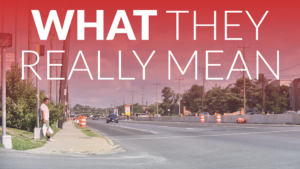Related Resources
Community Connectors Portal: Tools for advocates > How things happenPlanning 101
A plethora of plans: what do they all mean?
The most important thing to understand about the sea of planning processes is that planning rarely directly informs decisions about spending (i.e programming) of transportation dollars.
Planning processes help establish priorities, but the processes for selecting individual projects for funding are where the real power is.
There is planning for individual transportation projects, and there is planning that takes place at a much higher level. That higher level is what some call “system planning,” which is just catch-all jargon for the plethora of planning functions that take place continuously over many years and do not pertain to any single project. Though these planning processes should have more influence on how money gets spent, they are how state DOTs—and the MPOs and localities located within their states—decide what their priorities are. This is the place to engage as the overall vision often is laid out, which then influences which individual projects end up advancing into the planning process.
There is an ecosystem of interrelated planning processes and documents that can include:
- federally mandated long-range transportation plans (for states and MPOs)
- modal plans
- area or corridor plans (often developed in coordination with MPOs and local governments)
- asset management plans
- visioning documents
Types of plans
State DOTs are required to prepare a long-range transportation plan (SLRTP) that spans at least 20 years. These plans are typically updated every 5 to 15 years, following a public engagement process, and outline assumptions about the future, high-level policy goals, performance measures, and strategies intended to guide transportation investments and decisions across the state. To get a project funded, it has to be included in the four-year State Transportation Improvement Plan (STIP), which is the most important plan for advocates to know about and be involved with shaping. Unlike the long-range plans, a STIP is “constrained” which means it’s about spending the actual money that is available.
Additionally, MPOs are required to prepare a long-range transportation plan (LRTP) or a regional/metropolitan transportation plan (R/MTP) spanning at least 20 years, in coordination with the state DOT. Plans must be updated at least every five years, or every four years in areas identified as having levels of air pollution that don’t comply with federal law (i.e, air quality nonattainment and maintenance areas.) Unlike the statewide long-range plans that are completely blue-sky with no attempt to match up to available funding levels, these metro area plans are “fiscally constrained” and have to line up with projected available funding.
More specific planning documents also interplay with state and regional LRTPs. Local governments pass comprehensive plans that guide the development of their built environment, including transportation infrastructure. And transit agencies have strategic plans that look one to two decades ahead and are updated every five years. Regional and state long-range plans should be consistent with both of these plans.
Sometimes there are medium- to long-range sub-plans that focus on individual modes such as highways, rail, transit, active transportation (i.e. bicycle or pedestrian), freight, or for specific strategic initiatives, like intelligent transportation systems or improving access to major trip generators, such as universities, military installations, or sporting venues.
Finally, transportation asset management plans (TAMPs) let DOTs and transit agencies track the condition of existing infrastructure and prioritize assets (i.e. roads, bridges, rails, transit vehicles) that are in the greatest need of repair or replacement.
What actions can you take?
Influencing your state DOT, MPO, local government, or transit agency so that their long-range plans prioritize moving people over vehicles is certainly worthwhile. But, that shouldn’t be mistaken for success.
For example, California’s long-range plans repeatedly state the importance of emissions reductions, while the projects that they continue to approve for the short-term STIP expand roads in ways that will increase emissions. That story is repeated in numerous states and metro areas. The planning process is a worthwhile place to make priorities clear, but the processes by which projects are actually selected for funding, which we address in this explainer, is where the real power is.






